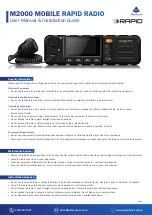
111
This document is intended for Public Distribution
19473 Fraser Way,
Pitt Meadows, B.C. Canada V3Y 2V4
Appendix G
G-1
TR-SL2 Series
Tranzeo Wireless Technologies
To many people, routing can be a black art. So many explanations of routing explain the binary logic
behind it, but not how to actually use it. This document is designed to offer some practical advise on routing
based on some of the common questions our customers ask us. It is not intended to be the definitive source
of all routing info. For a detailed description, just do an Internet search for routing.
Many customers are familiar with a peer-to-peer network, and have never had to deal with connecting two
networks together. In a simple Peer-to-Peer network, every machine talks to every other machine. This
works well when there are 10 machines on the network, but just imagine if there were one million machines
on the network. The answer is to split the millions of units into manageable pieces, or subnets.
Whenever you set up a new machine on an IP network, the minimum IP requirements contain three things,
the address of the machine, the subnet mask for the machine, and the default gateway. Let‘s imagine that
you just moved to a new neighborhood. You need to know three major things to get around, the address of
your house, the street you live on, and since you haven‘t got your internet access set up yet, where the
mailbox is to send your change of address cards. In simple English, the IP info is the house number of the
machine, the sub net mask says what street its on and the default gateway is where the mailbox is located.
On a network, the mailbox is a router.
Figure out how many IP‘s you want to give each location. Find in the maximum IP column the value closest
to, but greater than the number of IP‘s you want to give out. That is the column you should use for your
network
On an IP network, machines can only send data to
here
or to
there
.
Here
is the IP‘s that are within the
subnet. If the data isn‘t from here, how does it get to
there
? The answer is that the device sends it to the
Gateway.
The subnet mask tells the machine who is nearby, and who is not. That‘s all it knows. So for example, lets
take a machine with an IP address of 10.10.1.1 on a subnet mask of 255.255.255.0 and a Gateway of
10.10.1.254. The machine has some information for a machine at the address of 10.1.2.1. The subnet mask
of 255.255.255.0 tells the computer that everything that that has an address starting with 10.10.1 is in the
same network. There is a complicated formula to figure out what the subnet mask means, but above is a
table of values for some common situations. Since 10.1.2 does not equal 10.10.1, the data is sent to the
Gateway, which is also called a Router.
What do you mean by a routable subnet?
So how does this IP thing work?
So how Do I figure out the Subnet Mask?
So what is a gateway?
Appendix G: Routing Quick Start Guide
Maximum Number
of IP’s per Subnet
Maximum Number of
Subnets
Sub Net Mask to Use
Total IP’s Available
6
32
255.255.255.248
192
14
16
255.255.255.240
224
30
8
255.255.255.224
240
62
4
255.255.255.192
248
126
2
255.255.255.128
252
254
1
255.255.255.0
254
















































